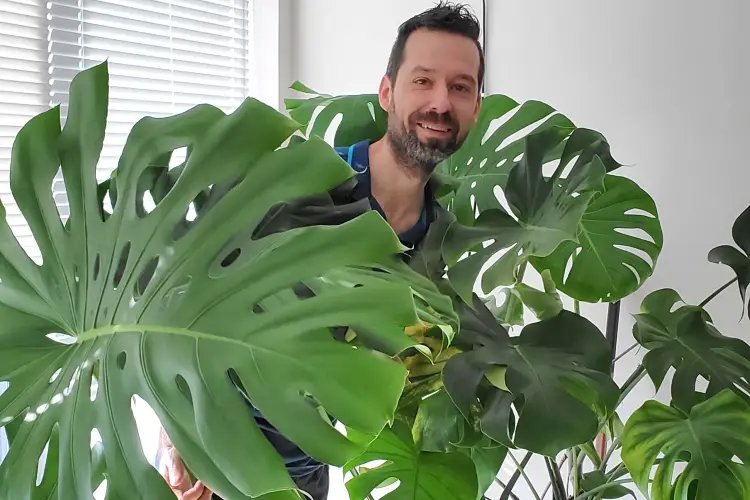
Is Monstera Deliciosa care simple? What are its light requirements, watering needs, temperature, or humidity? What are the best propagation tips? What to do with Monstera aerial roots? If you are asking these or other questions regarding Swiss cheese plants such as which soil to use, how to repot, or how to handle pests and diseases, keep reading this article.
| Botanical Name (Latin Name/Scientific Name): | Monstera deliciosa |
| Common Name: | Swiss cheese plant; split leaf philodendron |
| Light: | medium light (1,000 lux – 2,500+ lux) |
| Watering: | once the top half of the soil is dry |
| Soil: | well-draining mix |
| Repotting: | once a year |
| Temperature: | 65°F to 75°F (18°C to 24°C) |
| Humidity: | 25% to 50%, but it adapts well to any humidity |
| Toxicity for Pets: | Yes (vomiting, problems with swallowing, mouth, lips, and tongue irritations, drooling, burning) |
| Toxicity for Humans: | Yes (mouth, tongue and lips irritations) |
| Propagation: |
|
| Pruning: | Prune dead or diseased growth or when you want the plant to branch out |
Light Requirements
| Minimal amount of light: | 1,000 lux (100 FC) |
| Optimal amount of light: | 2,500+ lux (250+ FC) |
| Direct sun tolerance: | 2-3 hours |
| Category: | medium light |
Monstera Deliciosa is a medium-light plant. It can tolerate low light conditions as low as 1,000 lux, but the optimal amount of light it needs is bright indirect light, over 2,500 lux. If you can provide more light, monstera will have more leaf growth, more branches, more fenestrations (slits or holes in the leaves) and will be healthier. It will also be more resistant to pests and diseases. To provide the optimal amount of light, place your Monstera in front of a south, west, or east-facing window.
The following research has confirmed that monstera is a medium-light plant and the light levels it needs:
- In the 2020 publication “Lighting for indoor plants and starting seeds” by Julie Weisenhorn and Natalie Hoidal, horticulture educators and Neil Anderson, a horticulture professor from the University of Minnesota Extension, confirm that Monstera Deliciosa plant is a medium light plant.
- 2006 publication (reviewed in 2022) “Growing Indoor Plants with Success” by Bodie E. Pennisi, Professor at the University of Georgia confirms that the optimal amount of light for Monstera Deliciosa plant is over 2,500 lux (250 foot candles).
- According to the research publication “Light Management in Greenhouses” by James E. Faust, associate professor of horticulture at Clemson University, more light leads to more leaf growth, more branching, and a higher quality plant. The research also confirms that medium-light plants grow best in bright light conditions.
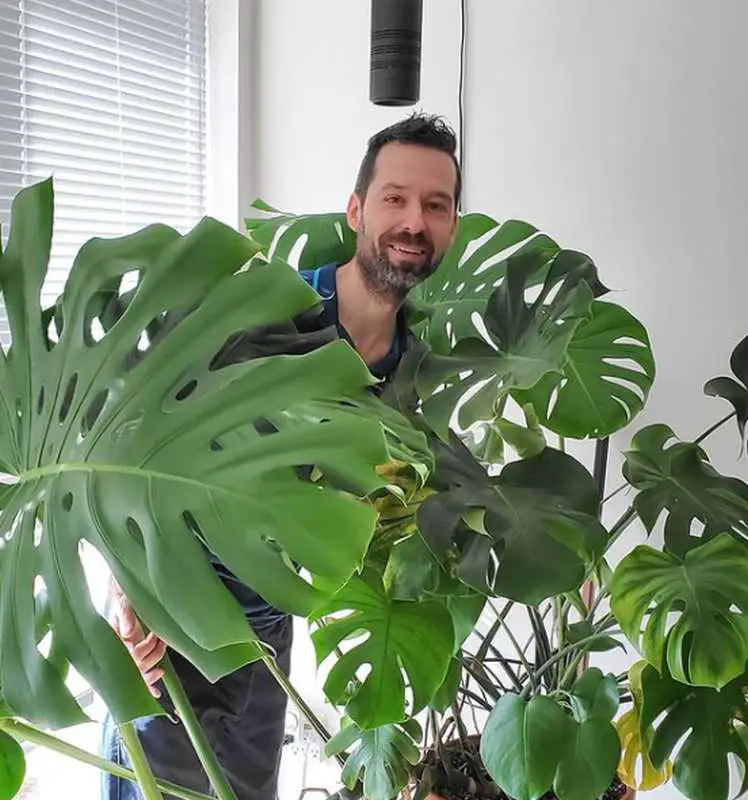
Mr. Houseplant with his Monstera, a gorgeous home decor addition
For example, my Monstera is in front of a southwest-facing window, getting over 5,000 lux of bright indirect light most of the day and several hours of direct sunlight. On clear days, it gets direct sun from 11 am until 3 — 4 pm. Direct sun provides between 40,000 and 100,000 lux of light. So 1 hour of direct sunlight can replace tens of hours of indirect sunlight. If you’re not sure what is indirect light for plants, check out the blog post on the topic.
If you can’t provide this amount of natural light, grow lights can supplement it. I have a grow light about 1.5 feet above the plant that’s on from 8 to 12 hours per day.
I recommend using grow lights if:
- your Monstera Deliciosa doesn’t get enough natural light in spring and summer
- if you want (or need) to keep your Monstera in a dark corner
- if you need to supplement bright indirect sunlight during autumn and winter to allow your Monstera to continue growing during these months
- to supplement natural light even during spring and summer because you want your plant to thrive, not just survive, at all times.
If you’re considering getting a grow light to meet your Monstera light needs, quickly explore my Grow Light Finder, but in case you’re worried about grow light electricity cost, check out my detailed article on that topic.
Water Needs
Water your Monstera Deliciosa once the top half of the soil dries out. The following expert guidance illustrates this point. 2006 publication (reviewed in 2022) “Growing Indoor Plants with Success” by Bodie E. Pennisi, Professor at the University of Georgia confirms that the optimal watering for Monstera Deliciosa is once the top half of the soil dries out.
If your Monstera Deliciosa is potted in a terracotta pot (which allows the soil to dry out faster than soil in plastic or ceramic pots) of appropriate size (larger pots may take longer to dry out) with a porous soil mix and gets lots of light throughout the day, the soil will dry out fast. In these conditions, you will need to water your Monstera thoroughly more often then if you had a lower amount of light, different pot type, or potting mix. Fast drying and rehydration enable the roots to develop well.
If you like to bottom water your Monstera, water from the top every third watering. Let the excess water run out through the drainage holes, so that accumulated salts can come out and empty the saucer.
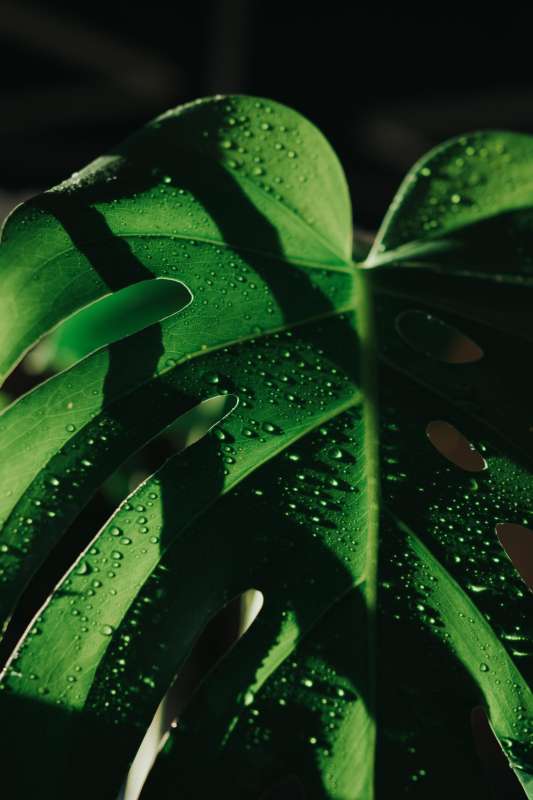
Monstera Deliciosa plant care includes proper watering
Avoid extremes when watering your Monstera Deliciosa; never overwater to avoid root rot but also don’t let your plant stay completely dried out for too long.
Humidity Needs
Ideal household humidity levels for Monstera are from 25% to 50%, but it can tolerate lower as well as higher humidity levels without any problems.
The following research has confirmed the ideal household humidity level for Monstera:
- 2006 publication (reviewed in 2022) “Growing Indoor Plants with Success” by Bodie E. Pennisi, Professor at the University of Georgia confirms that the optimal humidity for Monstera Deliciosa is between 25% and 50%
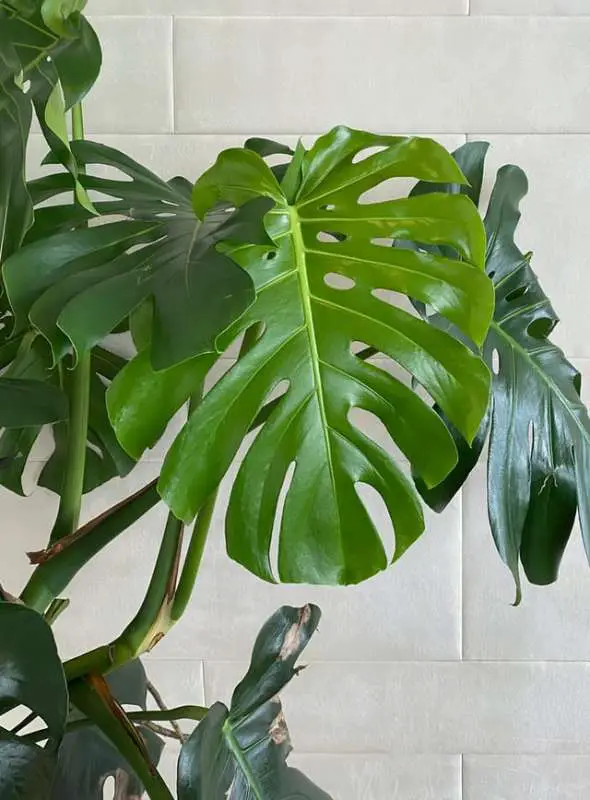
Monstera Deliciosa plant (split leaf philodendron) grown in bright indirect light
Temperature Requirements
The optimal temperature to grow Monstera Deliciosa is between 65°F to 75°F (18°C to 24°C). It will grow well in temperatures up to 85F (30C). If you can provide a temperature between 75F and 85F, it will grow leaves faster. Monstera can tolerate as low as 30 to 32°F (-1.0 to 0°C), below which the leaves will exhibit freeze damage.
The following research and expert guidance illustrate these points.
Optimal temperature. 2006 publication “Growing Indoor Plants with Success” by Bodie E. Pennisi, Professor at the University of Georgia confirms that the optimal temperature for Monstera Deliciosa is between 65 F and 75 F.
Tolerates as low as 30 to 32°F (-1.0 to 0°C). A study by professor Jonathan H. Crane, from the University of Florida, IFAS Extension, and professor Carlos F. Balerdi, from the University of Florida, IFAS Extension, confirms that monstera is not tolerant of freezing temperatures and that leaves will freeze at temperatures below 30 to 32F (-1.0 to 0°C) and stems at temperatures below 26 to 28 F (-2 to -3C).
Temperature between 75F and 85F provides faster growth. The research publication “Light Management in Greenhouses” by James E. Faust, associate professor of horticulture at Clemson University, confirms that temperature has a big impact on how fast leaves develop and that higher temperature provides faster leaf development.
Fertilizing
Fertilize your Monstera plant during the growing season (not only spring and summer, but also fall and winter, if your plant is growing during fall and winter) with a 3:1:2 houseplant fertilizer. The best houseplant fertilizer is the Sill fertilizer. Why? Because it has the perfect N-P-K ratio of 9-3-6 which is excellent for all foliage plants. It will allow your Monstera Deliciosa to grow much better.
If you repot your Monstera plants once a year, you don’t need to fertilize them, as fresh soil will provide sufficient nutrients for the plants.
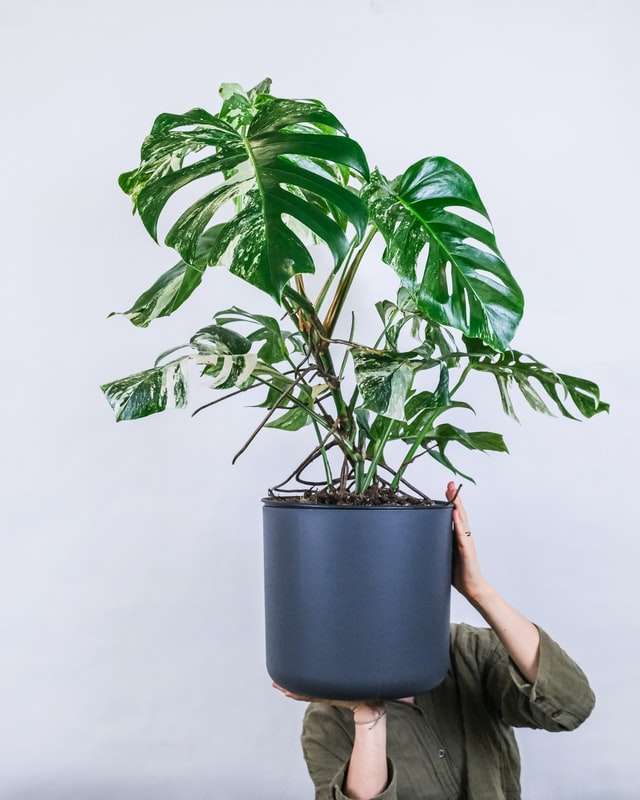
Monstera Deliciosa (Swiss Cheese plant) requires a complete fertilizer with all 16 minerals
Soil
The best soil for Monstera plants is 1 part any peat moss based potting mix, 1 part perlite, 1 part bark. This mix will create a nutritious, oxygenated potting soil that Monstera Deliciosa loves. The following expert guidance has confirmed this. Bodie E. Pennisi, Professor at the University of Georgia confirms in his 2006 publication “Growing Indoor Plants with Success” that the best soil for monstera contains 1 part peat moss, 1 part perlite and 1 part bark.
Monstera Deliciosa prefers well-draining soil which is why it’s important to add some of these amendments (perlite and bark) to any potting mix you intend to use for potting it. Adding larger, coarser particles to conventional potting mixes creates larger pores in the soil that will hold oxygen and allows the soil to dry out faster.
Repotting
Here are the 5 steps to properly repot a Monstera plant:
- Make a potting mix: ⅓ potting soil, ⅓ perlite, ⅓ bark.
- Select an appropriate pot for your Monstera by getting the next pot size. If your plant is in a 4” pot, get a 6” one. Use a pot with at least one drainage hole. Several drainage holes are preferable.
- Take the Monstera out of its pot (i use a repotting rake to help, and it makes my job much easier) and lightly loosen the rootball, then untangle the roots (you can use the other end of the repotting rake for that). If you see signs of root rot (soft, mushy roots), cut them off.
- Fill ⅓ of the new pot with soil, put the plant in, and fill the remaining space with soil.
- Press the soil around the plant firmly and water. Let the water drain from the drainage holes.
If you can wait until the soil dries out before repotting, please do, because it will be easier to take the plant out of the pot.
I repotted my Monstera Deliciosa after the purchase in a mix of peat moss, perlite, and vermiculite. This made the mix porous, with lots of macropores that hold oxygen, which is crucial for healthy root growth. I moved it to a terracotta pot to help the soil mix not stay wet for too long. Because… healthy roots = healthy plants! :)
You can also see my monstera repotting video below:
If you need more information on repotting, or would like to learn the difference between full repotting and potting up, check out my article on how to repot a houseplant.
Toxicity To Humans
Monstera Deliciosa is toxic to humans. It contains oxalate crystals, which if ingested, can cause pain, swelling, and difficulty breathing and speaking. And the plant’s sap can cause a skin rash or irritation. The following expert guidance illustrates these points:
- Pain, swelling, irritation, difficulty breathing, and speaking. The California Poison Control System (CPCS) confirms that the sap of Monstera plants contains tiny oxalate crystals and that chewing on these plants can cause immediate pain and irritation to the lips, mouth, and tongue, and even breathing problems and swelling in the throat. Children’s Health Queensland Hospital from Queensland, Australia also confirms that ingesting the plant can cause difficulty breathing, swallowing, and speaking.
- Skin rash and irritation. Ann King Filmer, a Plant Scientist from the University of California, confirms in her publication “Safe and Poisonous Garden Plants” from October 2012 that the sap of the plant contains oxalate crystals which can cause a skin rash or irritation. If you get the sap on your skin, wash the affected area with soap and water as soon as possible. She also confirms that the plant can irritate the mouth, tongue, and throat which can result in burning pain, throat swelling, and difficulty breathing.
Toxicity To Pets
Monstera Deliciosa is toxic to pets. The American Society For The Prevention Of Cruelty To Animals (ASPCA) website states that this plant, if ingested, can cause vomiting, problems with swallowing, mouth, lips, and tongue irritations, drooling and burning.
Pruning
You can prune Monstera Deliciosa to remove dead and dry leaves. And if the plant is too big, you can trim it. Use sharp, clean scissors or pruning shears. Sterilize them and cut a stem below a node. Pruning encourages new growth and branching. And cuttings taken from the plant while pruning can be propagated, giving you new plants.
Staking
Monstera Deliciosa plant is a vining plant (a climber) and often a fast grower, so it may need additional support. Plan to stake your Monstera plant in order to provide it with the support it needs.
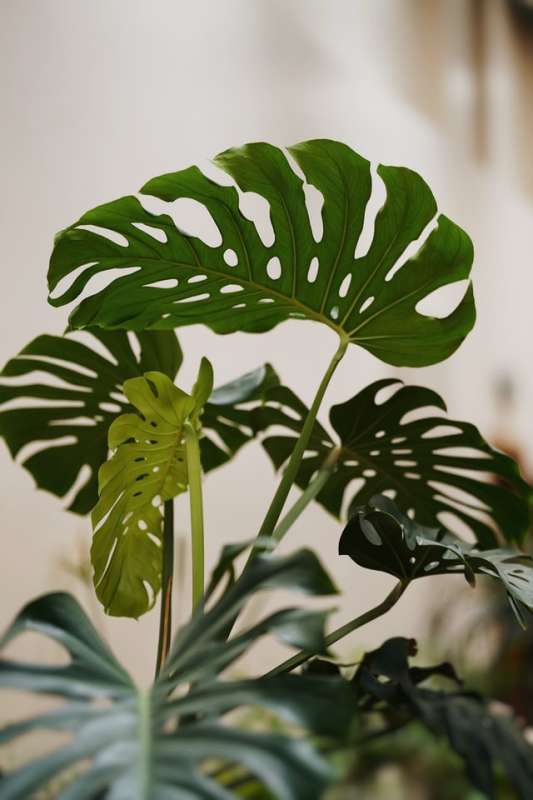
Swiss cheese plant grown in bright indirect light
When staking my Monstera, I’ve been thinking about using a moss pole, a trellis, or a metal stake, but I decided to go with a wooden stake. I love using wooden stakes as their ends are sharp, so they can easily be installed; they penetrate the soil very easily. Also, they are thin and don’t take up a lot of space as a moss pole. A moss pole also tends to make a mess if you let it dry out, which is another reason I avoid them.
When staking your Monstera plant, be sure the stake is well anchored. Use a thicker stake and twist ties to hold stems to the stakes for heavier plant stems.
If a stem has been growing horizontally and it’s too thick to pull it into a vertical position to tie to the stake, you can gradually tighten it until it reaches the stake. You can also make a few notches on the stake so twist ties do not slide down. If there are some stems that you can’t fully pull up to the stakes, just keep tightening every couple of days until they do.⠀
You can see how I staked my huge Monstera in the video below.
If some of your Monstera vines start falling to the floor and you don’t feel like staking the plant yet, turn it so the vine in question can lean against the wall.
Propagation
Monstera plant can be propagated by stem cuttings in water, stem cuttings in soil, division, and air layering. The most common way of propagation is by stem cuttings in water. To propagate a Monstera, follow these steps:
- Cut a stem just below a leaf node (the point on the stem where leaves or aerial roots grow out)
- Place the cutting in a jar or vase with water, making sure that the cut end and the node are submerged
- Keep the jar or vase in a warm, bright location
- Change the water 1-2 times a week to prevent the growth of anaerobic bacteria
- After several weeks, roots should begin to form
- You can then transplant the cutting to a pot with well-draining soil
You cannot propagate individual Monstera leaves with a petiole, because they lack an axillary bud (a dormant bud) that can grow new leaves.
Top 7 Monstera Propagation Tips
Here are my top 7 Monstera propagation tips.
- Make at least two cuttings: First make a tip cutting of one vine, cutting below a node. Ideally find a node with an aerial root. This makes the cutting much easier to propagate. A node is the part of the stem where the leaf connects to it, it can produce leaves and roots. An internode is exactly what the name says, the part of the stem between two nodes. Internodes cannot produce leaves. Then make a second cutting below the next node.⠀
- Increase the amount of light.
More light → more photosynthesis → better chances of rooting.
Do not put your cutting in a dark corner. Instead, give the cuttings a warm spot next to a window with bright indirect light over 5,000 lux. If you can have 10,000 lux or more, that would be great. A few hours of early morning direct sun is even better; you will get 40,000 to 100,000 lux of light when the sun shines on Monstera leaves.
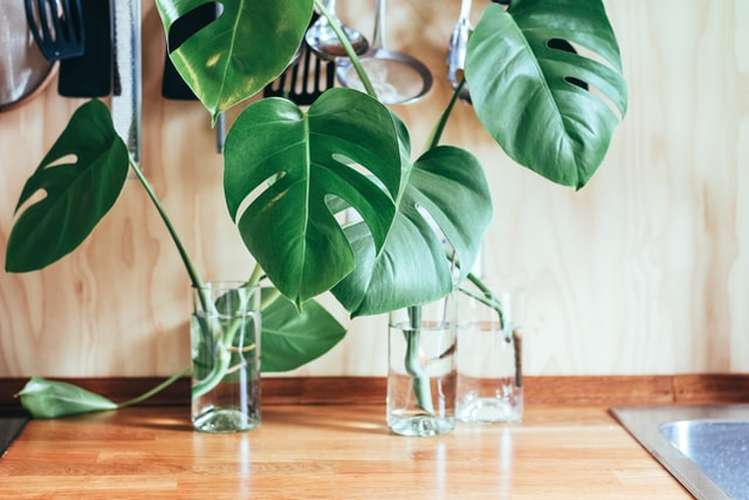
Propagating Monstera plants in indirect sunlight
- Add an air pump.
Roots absorb oxygen and release carbon dioxide. They need oxygen to grow. Over time, the amount of oxygen in the water will go down but an air pump will provide a constant inflow of oxygen. - Use a heat mat.
The optimal propagation temperature is 75°F to 79°F (24°C to 26°C). If the water is too cold or too hot, the conditions will not be the most optimal for a cutting to propagate. This doesn’t mean it will not propagate, but if it does, the process will take much longer. A heat mat can increase the temperature of the propagation medium by 5 to 10 degrees, increasing your chances of success. - Replace the water regularly, at least once a week.
You want clean water, water without bacteria that could potentially infect the wound and kill the cutting. With an air pump, you won’t need to replace the water as often as you usually would, but still, replace it as soon as you notice it not being clean. - Make sure the node and aerial roots are ALWAYS underwater.
Some water will evaporate, some will be used by the cutting. Eventually, the level will go down. Keep the node and aerial root underwater at all times, so they can produce roots. - Hope for the best.
Not every cutting will root, even if you do everything right. It is very important to remember that we can provide the best conditions and hope for the best, but we can’t control nature. This is why you should always take several cuttings. A few cuttings may die, but others may propagate. The more cuttings, the more chances to succeed.
You can also see my Monstera plant water propagation video below
and an update after 5 weeks.
FAQs about Monstera Plant
My Monstera Is Not Forming Splits on Its Leaves — Why?
The most common reason for your monstera to not form splits on its leaves is insufficient light. Increase the light by a few thousand lux (few hundred foot candles) for several weeks and wait for the new Monstera leaves to grow.
If you’re looking to achieve higher levels of fenestration (leaf splits) try providing support for your Monstera, something they can climb on.
If you’ve provided optimal conditions for your Monstera to thrive, the cause may be its maturity — young Monstera plants need to mature in order to start forming splits on their leaves.
Why Does My Monstera Have Brown Spots?
Brown spots on a Monstera plant can develop due to several reasons – underwatering, overwatering, too much fertilizer, compacted soil, pest infestation, fungal or bacterial infection, or cold damage. Cut off the brown sections with a pair of sterilized scissors. To make sure it doesn’t develop new brown spots, repot the plant and place it in bright indirect sunlight over 2,500 lux. Do not fertilize. Water your Monstera once the top half of the soil has dried out and make sure it’s not exposed to below-freezing air. Inspect for pests. If you notice any, treat the plant with neem oil.
It’s important to look at the overall environment and care the plant is receiving to be able to properly identify the cause of brown spots. But if you followed all of the advice, no new brown spots should be forming.
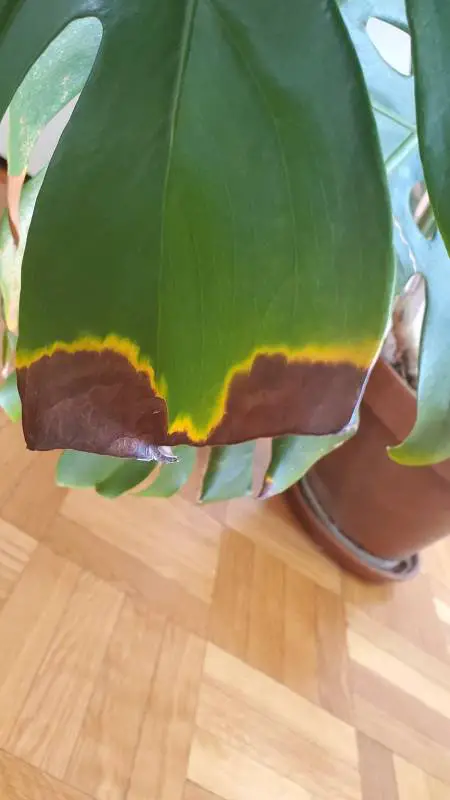
What should I do with Monstera aerial roots?
Sometimes, aerial roots on your Monstera plants can look wild and become unruly. In its natural habitat in Central America, Monstera uses aerial roots to climb trees in order to reach for more light. If your Monstera is not using the aerial roots to climb against a stake, or you didn’t put the aerial roots into the soil, the roots generally serve no purpose indoors. You can prune them without the fear that you will hurt your plant, it’s pretty safe. For more information on dealing with aerial roots, check out my Aerial Roots – Top 5 Tips for Dealing With Them article.
Have in mind that regardless of whether you cut off a stem, an aerial root, or a leaf, if there is a wound, there is a possibility of infection. This is why it’s generally a good practice to sterilize your pruning tools.
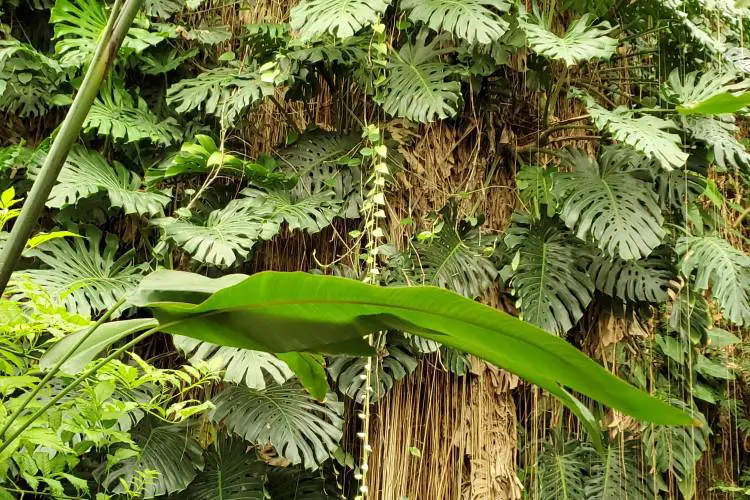
What Is The Monstera Growth Rate?
Healthy Monstera plants can grow at a rate of 1-2 feet per year, under the right conditions, including proper light, watering, temperature, and fertilizing. If provided the right conditions, they will grow not only during spring and summer, but also fall and winter.
Happy Growing Your Monstera Deliciosa!
Now that you have all the information on care for a Monstera, you can share this guide with your friends and family who are also Monstera parents or are thinking of getting a Monstera baby.
In case you have any additional questions about care for a Monstera plant or you need more advice, don’t hesitate to schedule a consultation with me.
Yours Truly,

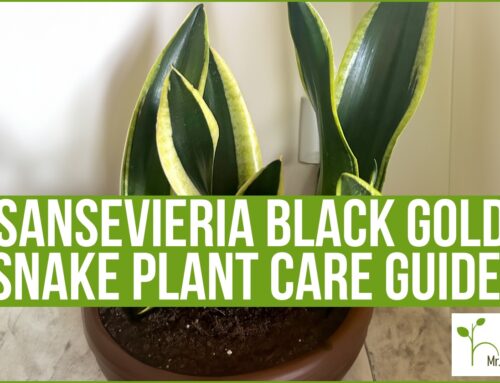

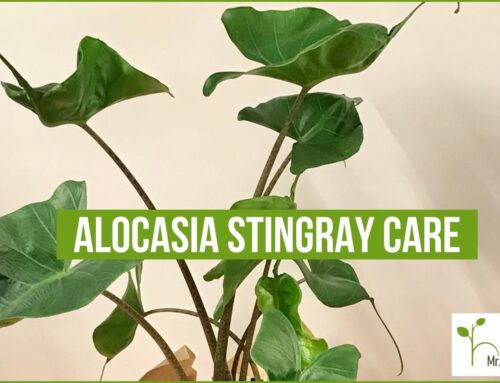


This is the best guide ever! Good job! I just got a monstera for my appartment, and this information is so helpful and complete! Thank you so much. A hug from Argentina!
Thank you so much Guti! I appreciate it ❤️